Garlic is an easy-to-care vegetable that makes your dishes tastier. Besides, it is also beneficial for health. Growing garlic is easy if you know the proper planting and caring tips.
Garlic requires 6-8 hours of sunlight, consistent watering, well-drained nutritious soil, and timely fertilization. It also needs cold treatment for vernalizing and hot temperature for root and bulb development. Garlic should be harvested when half leaves become yellow.
A lot of factors require consideration while growing garlic. This guide will take you through every requirement and care in detail, common problems, and ways to deal with them.
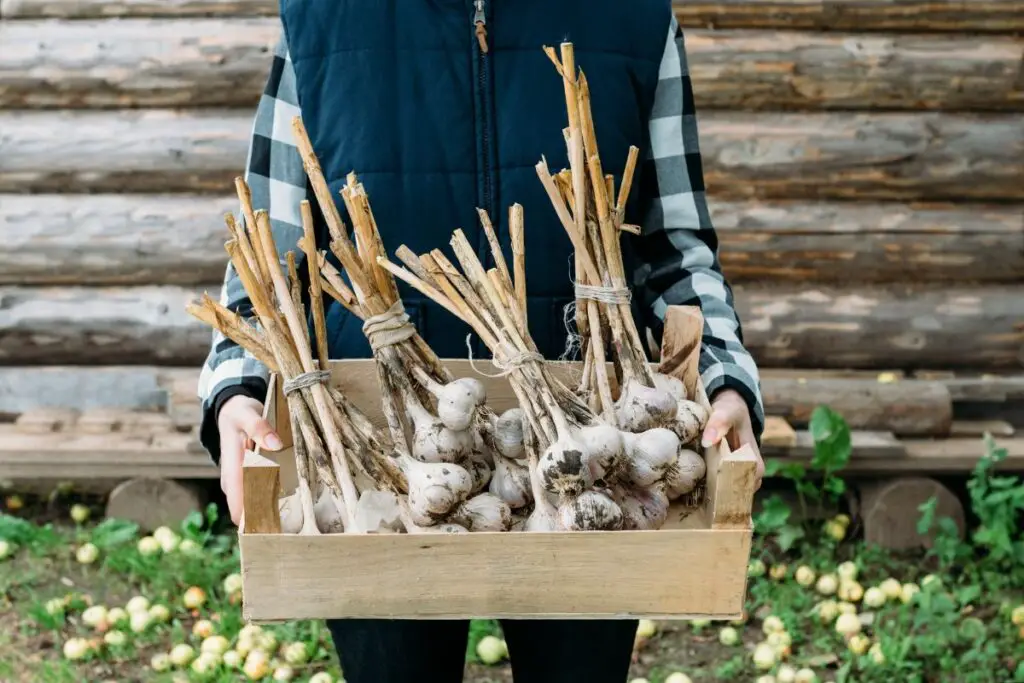
Garlic overview
Garlic is generally considered a flowering plant, growing from bulbs.
The vegetable is tasty, aromatic, and rich in sulfur.
It is used in various dishes to make food tastier.
Garlic is a member of the Allium family, and its cousins are onion, shallots, scallions, leeks, and chives.
The journey of garlic started in central Asia, became familiar in the Neolithic times, and then spread to the Middle East and North Africa in 3000 BC.
Garlic is one of the oldest crops grown in the world.
Though its journey touched every corner of the world, its origin is West and Central Asia.
Garlic comes in bulb form, and each bulb consists of many small and big cloves, depending on the variety.
Garlic also differentiates in color and size, depending on the variety.
Garlic varieties
Garlic comes in various species and cultivars.
But all of them are categorized into two groups:
- Hardneck
- Softneck
Hardneck
Hardneck varieties are ideal for and native to the colder zones.
Hardneck can tolerate cold and frost more than the Softneck varieties.
Garlic also needs a cold treatment for bulb development, and Hardneck needs enough cold.
The Hardneck stem growing from the bulb center is hard and rigid when mature.
Hardneck varieties produce flower heads or scapes.
Hardneck garlic is closer to wild garlic and doesn’t store well.
It has a shelf life of 3-4 months, so you must store and eat them within 6-10 months.
Some Hardneck varieties of garlic are:
- Rocamboles
- Porcelains
- Purple Stripes
- Marbled Purple Stripes
- Asiatics
- Glazed Purple stripe
- Turban
- Creole
Softneck
Softneck varieties are ideal for the warmer zones.
They require a less cold treatment for bulb development.
Besides, Softneck varieties can tolerate more heat than Hardnecks.
Softneck store well for a long time.
Their central stalks are not hard and grow leaves but no scapes.
Softneck is further divided into two types – Artichoke and Silverskin.
Some Softneck varieties of garlic are:
- Silver Rose
- Silver White
- French Red
- Blanco Piacenza
- California Early and Late Whites
- Inchelium Red
Elephant garlic
Elephant garlic is another kind of garlic.
It measures larger than the other two, like a cricket ball.
Though it is called garlic, it’s not a true garlic.
Instead, it belongs to the leek family.
The garlic can be stored well and cooked.
It has a gentle flavor.
Is garlic easy to grow?
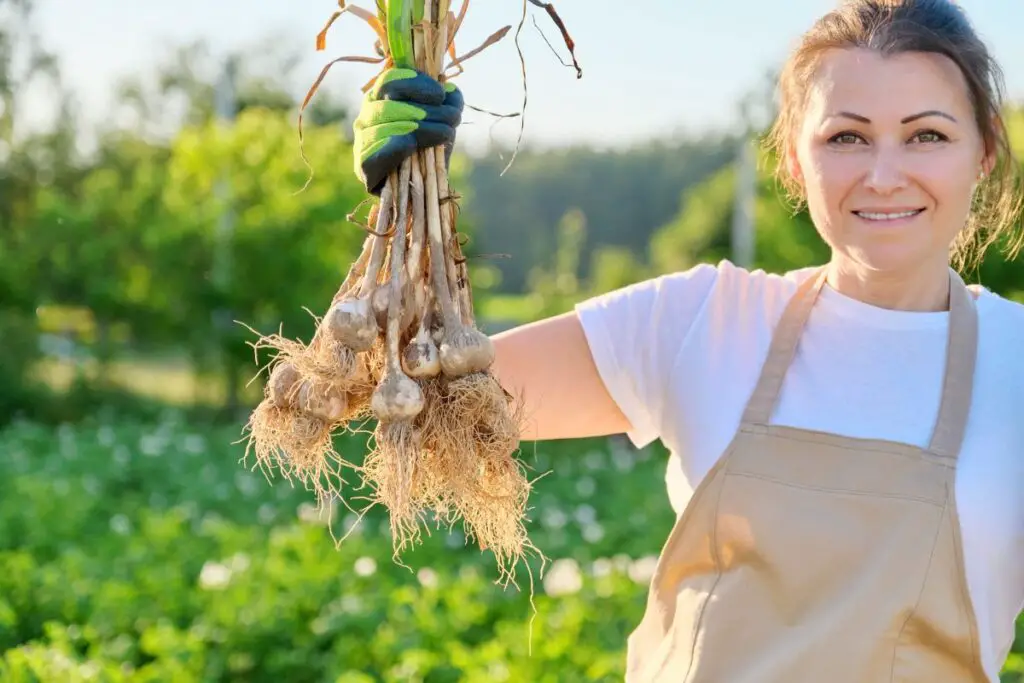
Garlic is easy to grow as it needs very simple requirements and doesn’t demand much attention.
Even if you are a beginner, you can grow them easily once you know the right planting and caring processes.
You will need a sunny location and well-drained soil mixed with compost manure.
You can even make your own raised beds.
Should I grow garlic indoors or outdoors?
Garlic is better grown outdoors than indoors.
Garlic doesn’t get the sun’s heat as it will get outdoors.
Besides, garlic can get a lot of space outside in the garden for growing bulbs and cloves.
You can still grow them indoors but won’t get garlic heads.
Instead, you will get garlic greens. The cloves will deliver green sprouts.
That is why it is always better to grow them outdoors in pots and on the ground.
When and how to plant garlic?
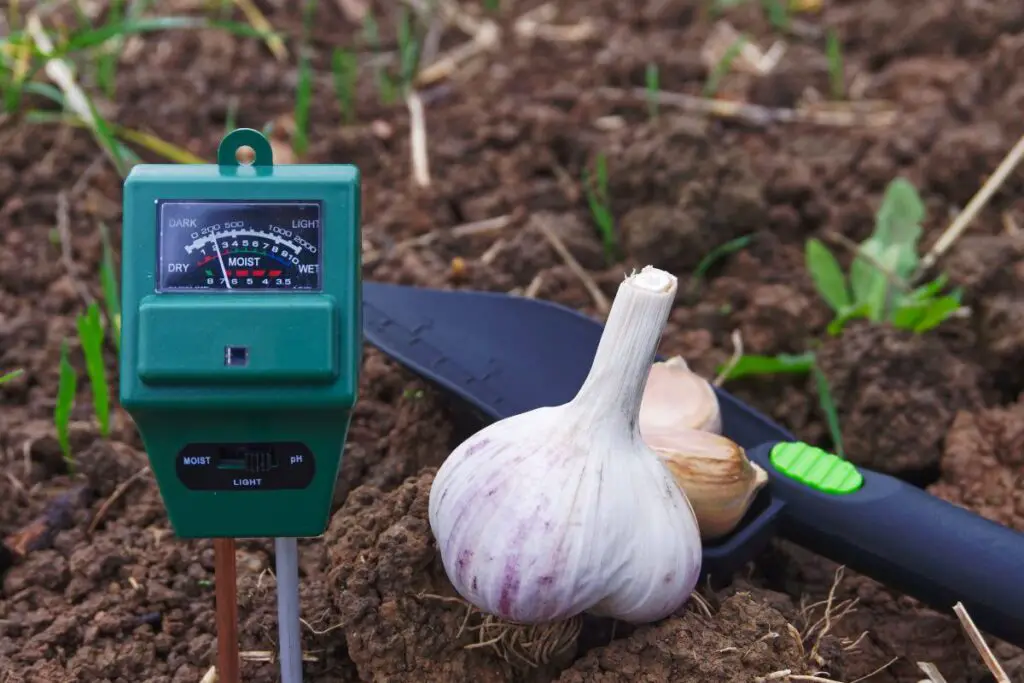
While growing garlic, it is essential to know the right time of planting and the right way to plant them.
You must plant garlic 4-6 weeks before the ground freezes.
The best time to plant garlic is in the fall.
The weather remains warm but slowly begins to get cool.
The time garlic gets before winter is enough for root growth.
Now, garlic needs cold treatment for vernalization.
They need at least 40-50°F for 6-10 weeks. Winter will fulfill this demand.
That is why fall is the right time for garlic.
Plant garlic in spring when the ground has de-freeze, in spring.
Refrigerate them for 8-12 weeks at 40-50°F for vernalization before planting.
If you want to plant them in summer, your region must have cool summers and warm winters.
If you plant them in late summer, the cloves will overwinter and continue growing up to spring.
Other than this, consider growing green garlic and harvesting them within 2-3 months.
If you want to plant garlic in winter, your region must not cross 40-45°F.
The cloves will grow roots, sprout, and continue to grow throughout the winter. Vernalize the cloves for 6-8 weeks before planting.
Also read: When To Plant Garlic Bulbs? (+Seasonal Guide)
Looking for gardening supplies? We have tested 100's of products before recommending them to you guys. Check out our best pick below:
| Image | Gardening Supplies | Best Price? |
|---|---|---|
 Top
Top Top
Top | Raised Garden Bed Kit | Check On Amazon |
 | XLUX Soil Moisture Meter, Plant Water Monitor, Soil Hygrometer Sensor for Gardening, Farming, Indoor and Outdoor Plants, No Batteries Required | No Results |
 Top
Top Top
Top | 82 Pcs Garden Tools Set and Extra Succulent Tools Set | Check On Amazon |
 | Joeys Garden Expandable Garden Hose with 8 Function Hose Nozzle, Lightweight Anti-Kink Flexible Garden Hoses, Extra Strength Fabric with Double Latex Core, (50 FT, Black) | No Results |
 Top
Top Top
Top | Dual Chamber Compost Tumbler | Check On Amazon |
 Top
Top Top
Top | Sunnyglade Plant Stakes | Check On Amazon |
 Top
Top Top
Top | Organic Cold Pressed Neem Seed Oil | Check On Amazon |
 Top
Top Top
Top | Mighty Mint Gallon :-Insect and Pest Control Peppermint Oil | Check On Amazon |
 Top
Top Top
Top | Scotts DiseaseEx Lawn Fungicide | Check On Amazon |
 Top
Top Top
Top | Jacks Classic 20-20-20 All Purpose Fertilizer | Check On Amazon |
 Top
Top Top
Top | 30,000 Seeds Pollinator Attracting Wildflower Mixture | Check On Amazon |
 Top
Top Top
Top | Survival Vegetable Seeds Garden Kit-Over 16,000 Seeds | Check On Amazon |
How to plant?
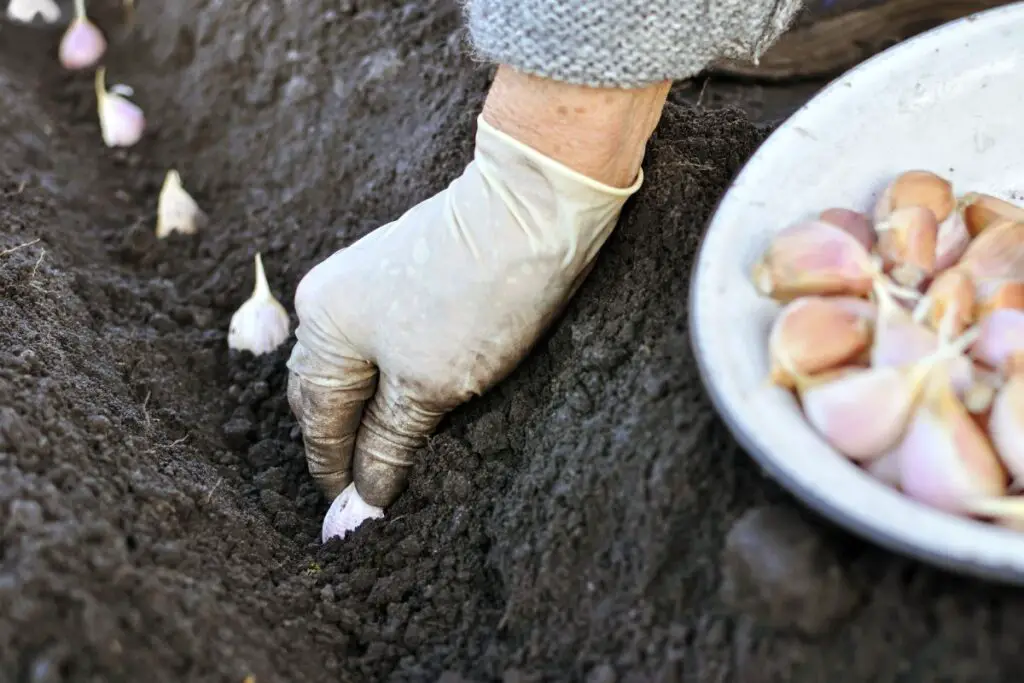
Find a suitable location for garlic, a place with enough sunlight and well-drained fertile soil.
Break and till the top few inches of the soil to loosen it.
Add compost to the soil bed to improve soil quality and drainage.
You can also add some fertilizer.
Make sure that soil pH is within 6-7.
Separate the garlic cloves and keep aside the biggest cloves for planting.
Bigger cloves produce bigger bulbs.
Place the flat end into the soil and keep the pointy end of the clove upwards.
Plant them about 2-4 inches deep and 4-6 inches apart.
Don’t plant too deep, too shallow, or too close.
Now, water the bed thoroughly to moisten the soil well, and add a layer of straw to cover the cloves.
Also read: How Deep And Far Apart Do You Plant Garlic?
Soaking garlic
Soaking is done before planting the garlic cloves or seeds.
It prevents several diseases and stimulates growth.
The seeds or cloves sometimes have many pathogens, bacteria, and pests unknown to our learning.
To prevent the diseases, you can soak the garlic in the following mixtures:
- Warm water heated at 100-115°F
- Hydrogen peroxide
- Baking soda
- Sterile or rubbing alcohol
You can also soak the garlic in some fertilizers to stimulate growth.
It also prevents diseases.
The fertilizers are:
- Diluted kelp
- Liquid fish
- Compost tea extracts
- All-purpose organic liquid fertilizer
Soak the bulbs only for 15-30 minutes, and not more than that.
Garlic care guide
Once planting is done, it is time to understand the care requirements.
Sunlight requirements
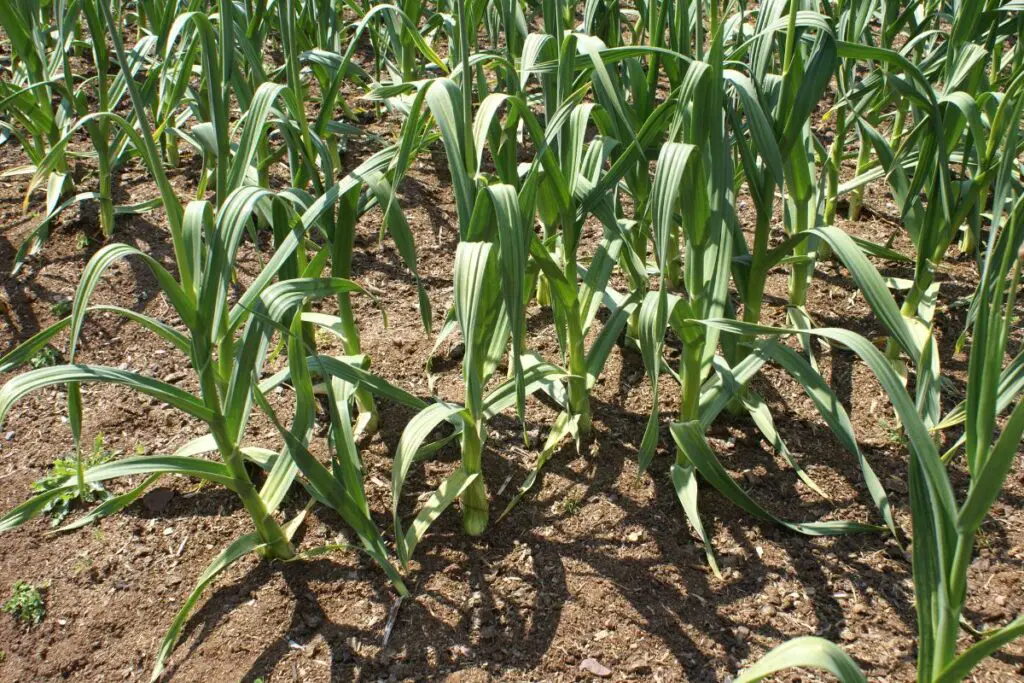
Garlic loves full sun. It needs at least 6-8 hours of sunlight per day.
The plant can also grow under indirect sunlight, provided it gets at least 3-4 hours of direct sun daily.
Without enough sunlight, the bulbs won’t develop well.
There will be a lack of photosynthesis, and the ground won’t dry out faster, resulting in poor growth and disease development.
However, not all garlic varieties need 6-8 hours of sunlight.
Some of them can thrive under only 4 hours of sunlight.
Without proper light, garlic can suffer from pink root, white rot, botrytis rot, and basal rot.
The plant will absorb as much sun as possible if it gets sufficient water.
It won’t suffer from direct sunlight; instead, it flourishes.
Also read: How Much Sunlight Do Garlic Plants Need?
Water requirements
Water the garlic plants every 3-5 days.
If there is rain, water them every 7-10 days.
Before watering the soil bed, let the top 1-2 inches of the soil.
Repeated watering without letting the soil dry causes overwatering and bulb rot.
When you plant the cloves, water the bed thoroughly.
Autumn means the rainy season.
At this time, skip watering for the first period.
Water the soil only when you find it dry.
In the winters, garlic remains dormant due to frozen ground.
So, you don’t have to water them.
When the garlic gets ready for harvest, stop watering 2-3 weeks before the harvesting date.
Also read: How Much Water Do Garlic Plants Need? (+How Often)
Soil requirements
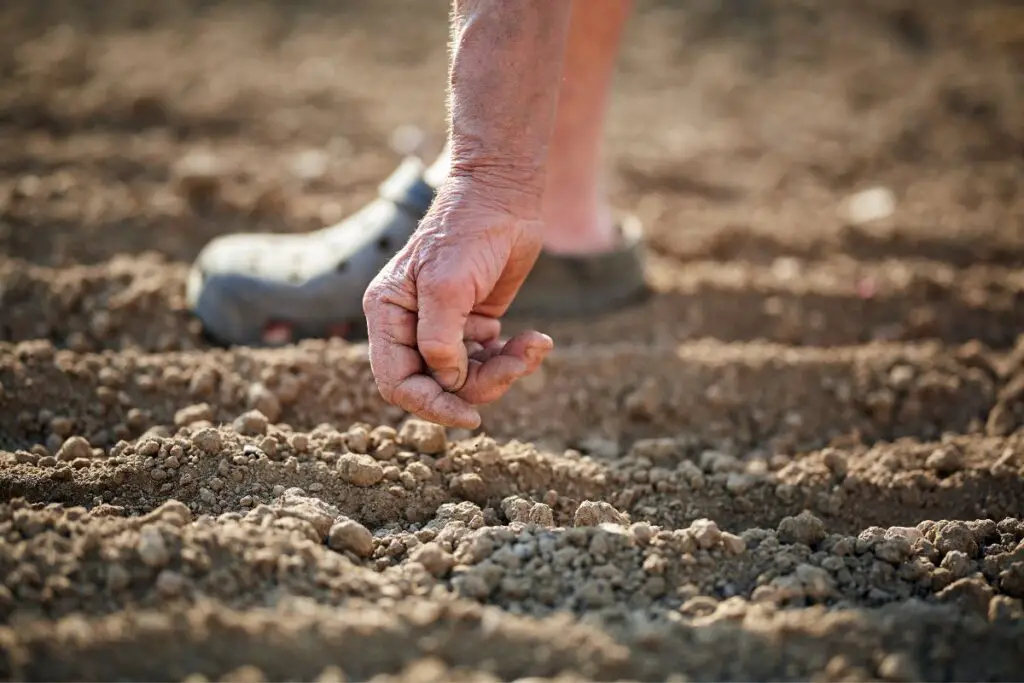
Garlic likes the soil to be fertile, moisture-retentive, and, of course, well-drained.
Before planting garlic, add compost and fertilizer to the soil bed to make it more nutritious and well-drained.
If your garden has clayey soil, you can still plant garlic if the clay is well-drained.
Otherwise, create raised beds separately.
Raised beds don’t accumulate any moisture.
Garlic can grow in any soil, provided you keep the watering correct.
For example, if it’s sandy, water more frequently.
If it’s clayey, water less frequently.
Before you plant the garlic cloves, ensure that the soil’s pH level remains between 6 and 7.
Also read: What Type Of Soil Is Best For Garlic? (Best Soil Mix For Garlic)
Fertilizer requirements
Fertilizing helps garlic in good growth and bigger, healthier, and tastier bulbs.
While preparing the soil for planting, add some balanced fertilizer (10-10-10) to make the soil more nutritious.
You can also add manure and blood meal.
Again fertilize the plant with a balanced fertilizer during the spring season either by side-dressing or spreading over the whole soil bed.
Do it every 3-4 weeks.
Again, fertilize the plant before the bulbs begin to swell, but lightly.
At this time, ensure you don’t use high nitrogen fertilizers that may stunt bulb growth.
There is no need to fertilize in winters. Since garlic remains dormant, they don’t absorb nutrients.
Fertilizing can cause overfeeding, which can cause small bulbs.
You can use both organic and inorganic and synthetic and homemade:
- Organic fertilizers are fish emulsion, blood and bone meals, kelp, humus, and seaweed.
- Compost manure includes cow and horse dung, pig, and goat manure.
- Household fertilizers are wood ash, Epsom salt, and coffee grounds.
Also read: When To Fertilize Garlic? (+Best Fertilizer For Garlic)
Temperature and humidity
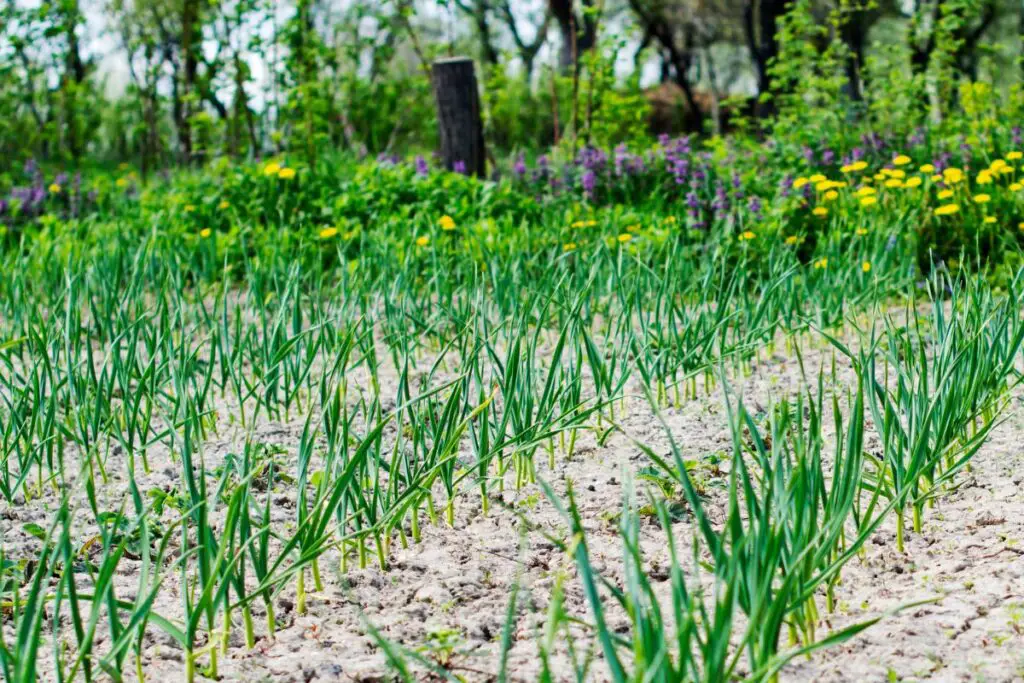
Garlic can tolerate both hot and cold weather at a great level.
The ideal air temperature for garlic growth is 70°F, and the soil temperature is 60°F.
In winters, garlic’s ideal temperature should be between 30-50°F.
But it can endure temperatures of -20 to -30°F.
Garlic needs 32-50°F for bulb development in the first two months.
Despite having endurance for hot weather, garlic can stop growing if the temperature crosses 90°F.
Temperature increases more under the sunlight.
So, keep the soil moist.
The more sun it gets, the more water it will absorb and keep growing.
Garlic suffers from cold and frosty temperatures if they are uncovered with mulch.
Garlic heads will die if they remain uncovered at 5-12°F.
Cover garlic with a thick layer of mulch using leaves, grass clippings, agro fiber, plant stems, or sawdust.
Garlic doesn’t require any humidity levels.
Also read: Garlic Plant Temperature Tolerance: Ideal Temperature+Extreme
Scape removal
The Hardneck garlic varieties grow scapes that need to be harvested.
Otherwise, the scapes will absorb all the nutrients and won’t let the bulbs have anything, resulting in smaller bulbs.
Scapes are usually flower stalks. Keep an eye on your garlic plants for escape growth.
When the scapes turn a circle into two rounds, cut them off the plant.
You can also use them in your dishes.
They are sweet to taste and have a garlic flavor.
Harvesting garlic
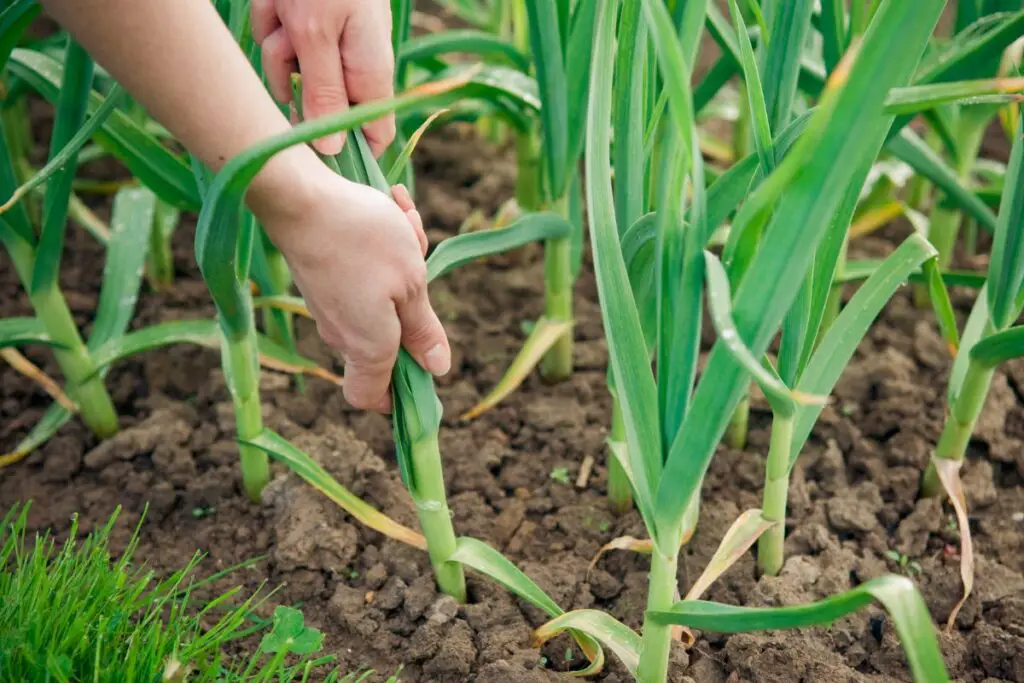
Harvesting garlic at the right time is crucial while growing garlic.
Late or early harvest can affect the garlic bulbs greatly.
To fix the right time for harvesting, look at the leaves.
When garlic gets ready for harvest, 40% of the leaves will turn yellow, especially the lower leaves.
Harvest the garlic bulbs when the plant begins to die, but before the whole plant dies.
Bulbs will split under the ground if you wait for the whole plant to die.
If this happens, you can’t store the bulbs. You can use them immediately. Sometimes, they might rot.
You should not harvest them early as that will give you small bulbs.
Besides, the bulbs will be full of moisture and take longer to dry.
If you want to harvest faster, consider growing green garlic.
You can harvest green garlic after 2-3 months only.
Also read: When Is Garlic Ready To Harvest? (+How To)
Curing, cleaning, and storing
Curing, cleaning, and storing are very important after harvest, especially if you wish to store them for next year’s planting and later use.
However, you can use cloves from the fresh bulbs for cooking.
Once you harvest the bulbs, keep them in the dark, cool, and dry place for 2-3 weeks and let them dry.
Don’t remove the leaves now, as the bulbs will absorb nutrients from them.
Once the leaves turn brown, remove them.
Still, you can’t remove all the leaves.
Aim only for the dirtiest ones.
Clean the bulbs by removing the soil from the outer body.
Make sure you don’t peel off the hard outer skin.
Find a cool, dark, and dry place for storing the bulbs.
The temperature should be around 30-50°F and average 45-50% humidity.
If you want to use containers, take a well-ventilated one.
Also read: How To Save Garlic For Planting? (Storing Garlic)
Propagation
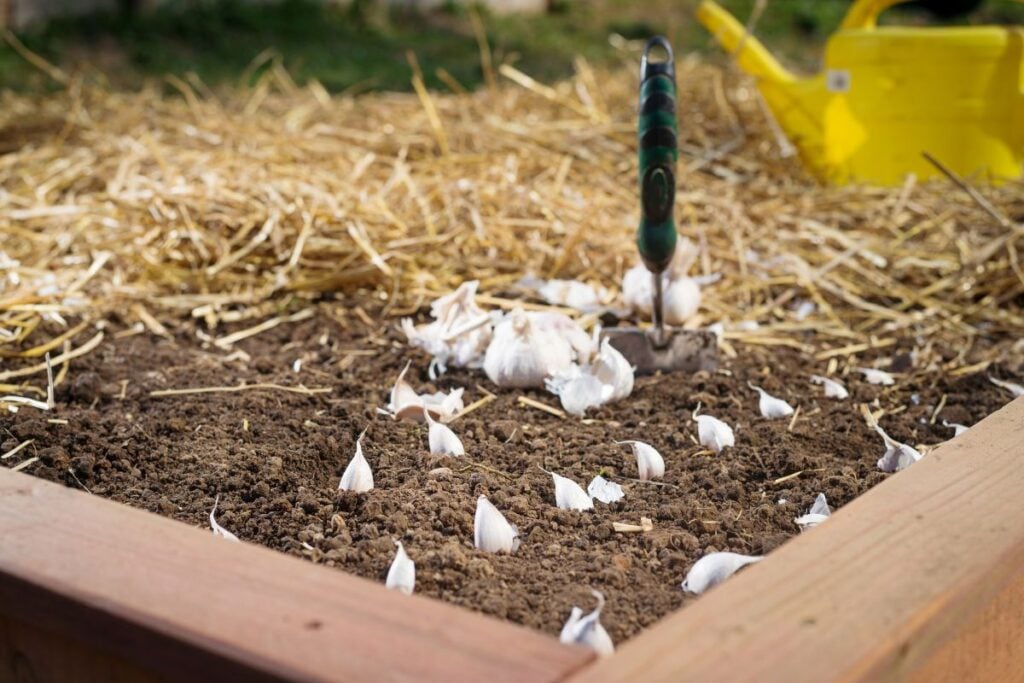
Propagation is the way from where you get more garlic.
The first method is from the cloves, which is the most common one.
Get a bulb and separate the cloves.
Plant only the bigger cloves.
Within 8-9 months, the cloves will turn into an individual bulb with multiple cloves.
The second method is bulbils, for which you must skip scape removal.
Letting the scapes stay diverts the plant’s focus on flowering.
The bulbil pod will be at the top of the scapes, where you will get multiple tiny bulbs.
Cut off the head and let it dry for 4-6 months.
After that, rub the pod to drop the bulbs and prepare them for planting.
Plant these bulbs 6 inches between each clove and the rows.
Give them 0.5-1 inch of water every week. Within 240 days, a plant will grow and mature.
In the next 240 days, bulbs get ready for harvest.
The third method is from seeds.
Before you do this, let me tell you that seed propagation has lower success rates than cloves and bulbils.
So, if you don’t get good results, try the other two.
Remove the small bulbs from the bulbils with tweezers and let the scapes flower and pollinate.
After 40-45 days of pollination, the seeds develop and prepare for harvest.
Collect the seeds and refrigerate them for 4 weeks. Soak them in water, fertilizer, or alcohol, then sow them in ordinary soil or sterile seed potting mix.
Garlic problems
Despite following these care tips, garlic will face some problems at one point.
The reasons can be both contagious and non-contagious.
It can be due to too much or too little water, lack of sunlight, or under-fertilization.
It can also occur due to pest and fungal infestations.
Let’s see what problems garlic may encounter.
Also read: Problems With Garlic Plants (Yellow, Brown, Drooping, Bugs, & More)
Garlic wilting or falling over
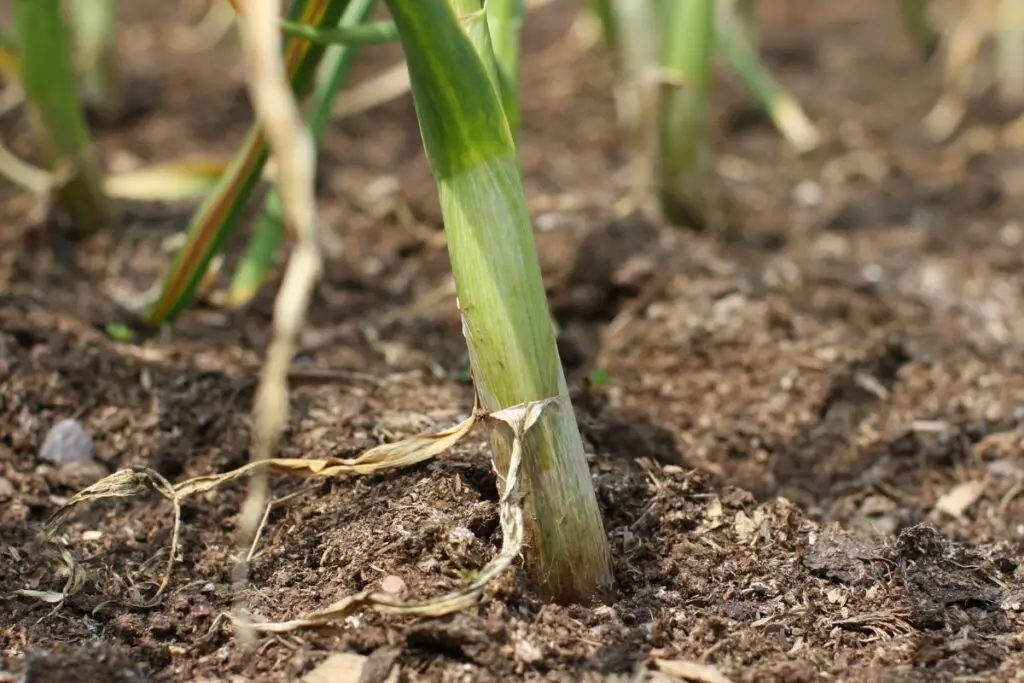
Sometimes, garlic plants can wilt and fall over overnight. Here are the reasons:
Harvesting time
When garlic is ready for harvest, the leaves turn yellow or brown and ultimately droop and fall over.
When this happens, dig out the soil from one plant to look at the bulbs.
If the bulbs seem mature and reach the desired size, harvest them quickly and don’t wait for the whole plant to die.
Garlic should be harvested when the plant begins to die but before the whole plant dies.
Overwatering or underwatering
Garlic needs to remain consistently moist and not soggy.
If the plant is drooping or falling over, consider checking the soil.
If it is wet, skip watering for some days.
But, if it’s dry, water the soil bed thoroughly.
In the winters and rainy season, it is better to skip watering.
Give garlic at least 2 inches of water per week, and let the top 1-2 inches of the soil dry out before the next watering.
Hungry plant
Drooping leaves is a sign of exhaustion and starvation.
Garlic is a heavy feeder; without proper feeding, the plant will wilt, and the bulbs won’t develop well.
Never forget fertilizing your plant.
There are three times to fertilize the plant:
- Before planting
- In spring, every 3-4 weeks.
- Just before the bulbs begin to swell
Pests
Leaves can wilt if bugs like wireworms and maggots attack the plant.
One easy method to deter them is to use brown mustard.
The smell will keep the bugs away from the plant.
Stunted growth
Stunted growth is another problem in garlic.
Below are some reasons:
Extreme weather
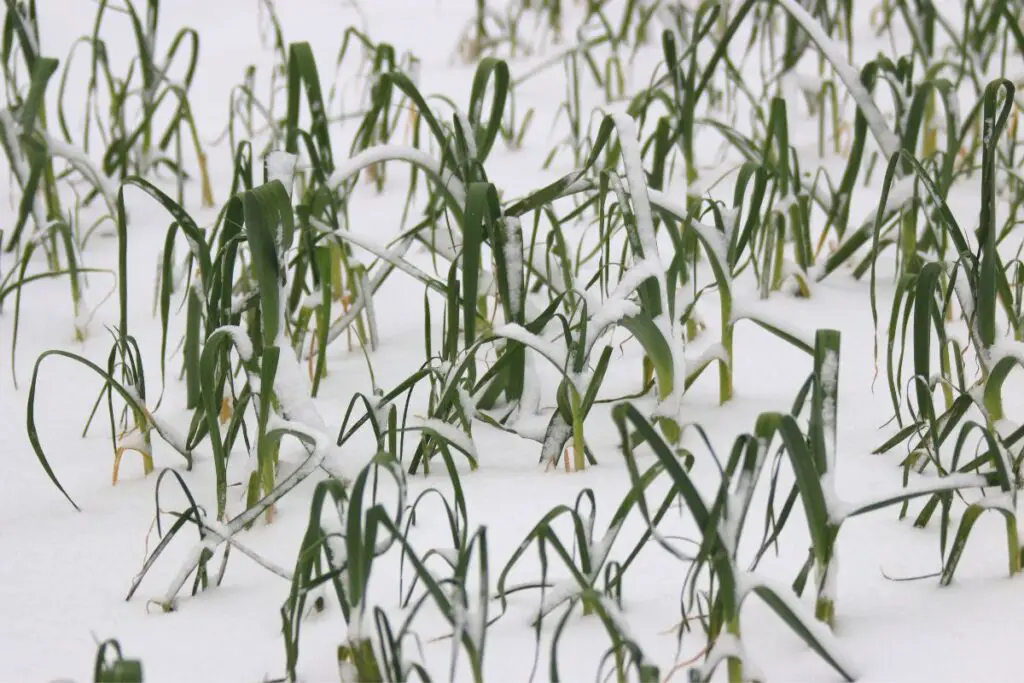
When winter gets extremely harsh, the bulbs can crush and have stunted growth.
It mainly happens when you don’t cover the cloves properly.
Thrips and nematodes
Thrips pierce the leaves and the plant sap, thus making the plant weak, wilted, and limp.
Nematodes enter the plant from wounds and damage the tissues, thus disturbing the system and stunting the plant’s growth.
Use sticky traps to trap the thrips and consider crop rotations.
Soak the bulbs in hot water heated at 100°F.
Planting worst companions
Plants like Sage, Asparagus, Peas, and Beans can stunt garlic growth.
These vegetables compete for moisture and nutrients, get exhausted, and finally stunt each other’s growth.
Try beetroot, cabbages, fruit trees, tomatoes, and chamomile for planting garlic companions.
Check the article on garlic companions.
Discoloration
The leaves turning yellow is generally a sign that the garlic is ready for harvest.
But there could be some other reason too.
Here are the reasons:
Poor planting
The plants grown from the small cloves are not as strong as those from the bigger cloves.
As a result, the plants from small cloves cannot handle changes and harsh weather, leading to premature discoloration and death.
The right depth for planting is 2-4 inches.
Shallow planting makes the cloves suffer frost damage.
The roots get affected and fail to work well, causing yellowing.
Plant at the proper depth and mulch them well.
Planting at the wrong time
Planting too early causes excessive above-the-ground growth.
When winter arrives, these plants will get affected and start yellowing.
Delayed planting causes delayed root growth, for which the plant easily gets affected by harsh weather conditions, causing yellow leaves.
Always plant at the right time. Don’t be too late or too early.
Follow the “when to plant” point to know more.
Lack of fertilization
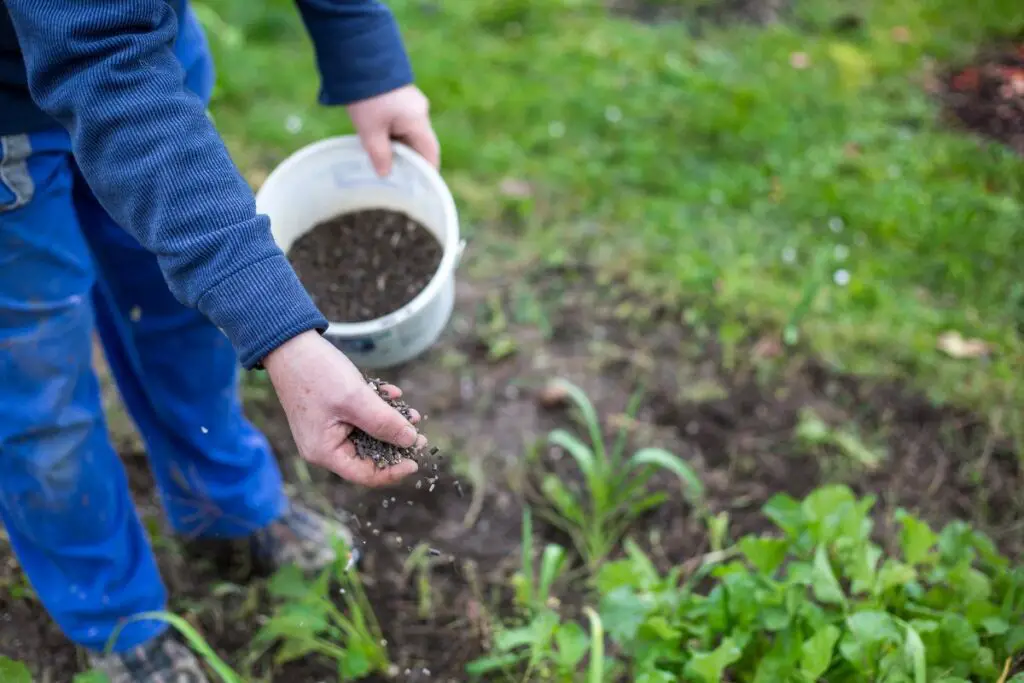
Lack of nitrogen causes yellow leaves.
When you fertilize garlic, make sure to go high on nitrogen when the plant has new leaf growth.
Add compost and fertilizer before planting.
Then, fertilize in the spring and again before the bulb begins to swell.
Improper watering
Lack of watering leads to yellow and droopy leaves.
Garlic soil should be consistently moist, especially for young plants.
Make sure to water them well.
Waterlogged soil can also cause yellow leaves as it suffocates the roots and prevents them from passing on the nutrients to other parts.
The rule is to water the plant deeply and keep the soil consistently moist, but let the top 1-2 inches of the soil dry before watering.
Soil acidity
Garlic soil needs to have a pH level of 6-7.
Constant fertilizer makes the soil acidic over time, turning the leaves yellow.
Add 1-1½ cups of wood ash before planting to avoid this acidity.
Pests and diseases
Pests like onion fly, thrips, and nematodes result in yellow leaves.
Plant companions like marigolds, cloves, and other companions to deter pests.
Soak the seeds or cloves before planting in warm water, alcohol, or soda to disinfect them.
Add dolomite to prevent and reduce bug spread.
Diseases include white rot, aspergillus niger, garlic rust, fusarium wilt, and Peronospora.
Since these are infections, yellowing spreads in no time.
Some bugs like dry weather, and some like moist weather.
Use this as an advantage while watering.
Garlic bulbs rotting
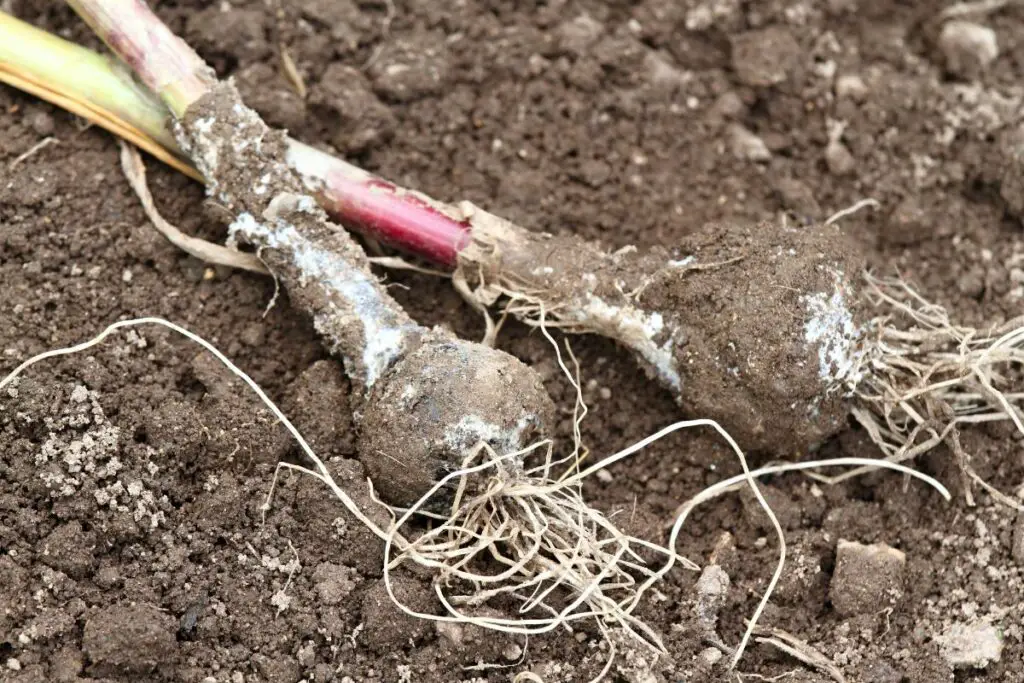
Garlic bulbs can rot due to diseases like basal rot, white rot, botrytis rot, and gray mold.
Rotting also occurs when the soil has improper pH levels, underground water rising, airtight soil, and frost damage.
Improper pH levels cause basal rot.
Make sure the pH level remains within 6 and 7.
Airtight soil doesn’t allow oxygen to enter the soil and the bulbs, which further rots the heads.
The soil must be loose.
Cloves can rot in winter if they are not covered well with mulches.
After planting, mulch the soil bed and add a thick layer of mulch in winter.
Lack of cure and good storage
After harvesting the garlic bulbs, they need to be cured by letting them dry for some weeks.
The bulbs need to be dry enough.
Storing in airtight boxes can also rot the bulbs by suffocation.
Use well-ventilated containers for storage; the humidity should be average, not high.
Garlic bulbs splitting up
Late harvest causes garlic cloves to split up in the ground.
Temperature fluctuations can do the same.
Hot weather encourages them to grow, and cold weather inspires them to stop growing.
It confuses the bulbs and remains split up in the ground.
Excessive water causes bulb rotting, for which the cloves split up in the ground.
Plant dying
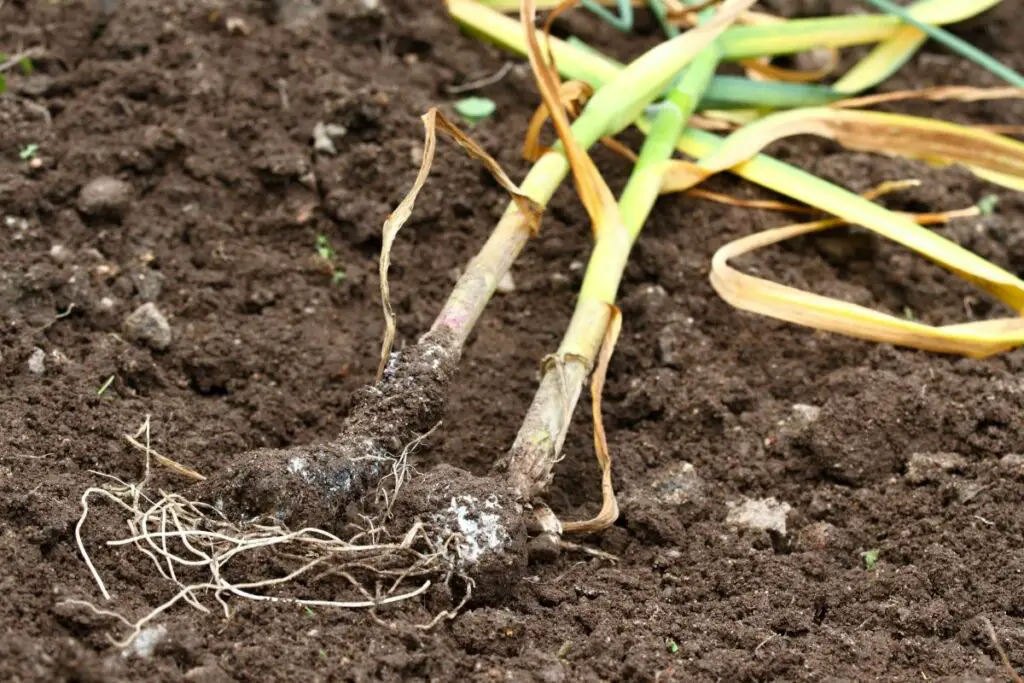
Garlic plants will begin to die and turn the leaves yellow and limp when it is time for harvest.
Other than that, premature death happens due to overwatering, underwatering, nutrient deficiency, and pests and disease infestations.
The plant will display the symptoms like yellowing, drooping, and discolored bulbs and then die.
A condition called frost-heave can also kill the plant.
It is a situation where the temperature fluctuates in winter.
One day, the weather is frosty and cold; the next, it is hot like summer.
This fluctuation cracks the soil around the roots and tears them, thus causing plant death.
Covering the cloves in winter will prevent this situation.
Small and deformed bulbs
Lack of water and nutrients and excessive fertilization are the common reasons.
Other reasons include:
Planting too close and too deep
You should plant the cloves at least 4-6 inches apart.
Close planting makes the bulbs fight for space and nutrients, get exhausted, and ultimately remain smaller.
Sometimes, the bulbs run over each other, causing deformation.
In deep planting, the tender cloves face underground soil pressure, for which the bulbs struggle to grow bigger, ending up with smaller bulbs.
Plant the cloves only 2-4 inches deep, or 6 inches if the weather is too cold.
Not harvesting the scapes
If scapes are left in the plant, they will absorb all the nutrients from the soil, and the bulbs won’t get any.
It causes smaller bulbs.
The more nutrients the bulbs get, the bigger they will develop.
So, harvest the scapes.
Garlic harvested early
Garlic should be harvested when 40% of the leaves have turned yellow.
Garlic bulbs grow best in their final months.
Taking them out early does not allow them to reach the desired size.
Planting late or early
If planted early, the plant will grow excessively and waste energy the bulbs could have used in spring.
This energy wastage results in small bulbs.
Late planting doesn’t give the bulbs enough time to develop roots before winter.
Lack of time and proper root development causes smaller bulbs.
The right time is 4-6 weeks before the ground freezes.
Compact soil
The soil needs to be loose so that the bulbs get space to develop flexibly.
Compact soil doesn’t let that happen.
The bulbs cannot spread well and remain small.
Smaller cloves
It’s common.
Smaller cloves give smaller bulbs, and big ones give bigger bulbs.
Garlic pests
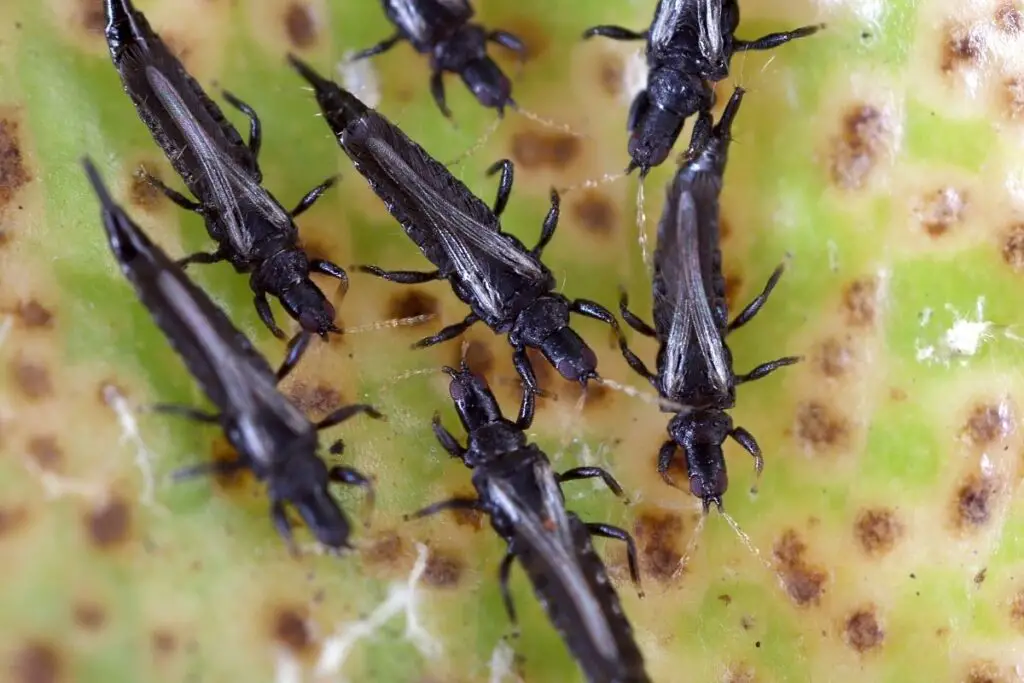
Garlic can be a food source for a lot of pests.
Here are some common bugs:
Bulb mites
These are common bugs that attack the garlic bulbs and result in bulb rot and stunted growth.
They also wound the leaves, thus creating an opening for other invaders.
To control the infestation:
- Use lay fallows to lessen the mite population.
- Soak the cloves with hot water before planting to make them strong to fight the infestation.
Nematodes
These are tough to get rid of.
Nematodes enter the leaves through some wounds, stay there and damage the leaves and tissues from inside.
You can control small infestations, but huge infestations will kill all the plants.
To control the population:
- Cook the bulbs in hot water heated at 100°F for 20-30 minutes to treat the bulbs.
- Consider crop rotation to prevent the infestation from further appearing.
Onion maggots
These pests will stunt the plant’s growth, wilt the leaves, and rot the bulbs.
When you pull the plant to harvest the bulbs, it breaks at the ground level.
The females will lay eggs every 2-4 weeks, for which the population increases drastically.
The bulbs become deformed and damaged during storage.
To prevent this:
- Keep the surroundings clean.
- Use floating row covers in early spring to prevent them from laying eggs.
- Spread wormwood over the soil bed.
- Plant carrots at a distance with garlic
Onion butterflies
These bugs attack mostly the allium family in the middle of spring.
They lay eggs under the bulb base, leaves, and peduncles. The larvae damage the flower stalk, stem, and leaves.
The bulbs fail to receive enough nutrients from the soil and stop growing.
A sign of the infestation is wilted and distorted leaves and the death of the lower leaves.
To prevent the infestation:
- Plow deep after harvesting the bulbs.
- Rotate the crops at a time cycle of 3-6 years.
- Ensure air circulation
- Get rid of dry tops after harvest.
Thrips
Thrips pierce the leaves to suck the plant sap, weaken the plant, and damage plant growth.
To prevent infestation:
- Keep the soil moist as thrips enjoy hot and dry weather.
- Use insecticidal soaps like bonide, spinosad, and neem oil.
- Release natural predators like ladybugs, lacewings, pirate bugs, and parasitic wasps.
- Consider crop rotation
- Plant companions with a strong smell like marigolds, dandelions, and dill.
Garlic diseases
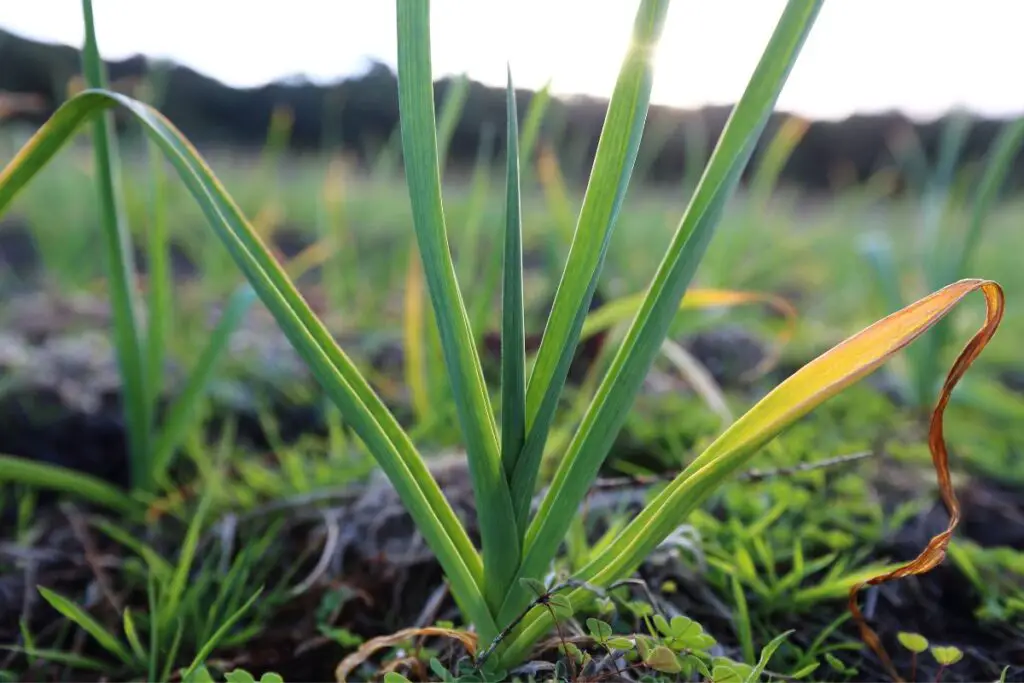
Garlic will have some threatening diseases.
Fusarium basal and root rot
The disease to notice as rotting starts at the roots, and then the infection spreads to the bulbs, turning them light pink or yellow.
The leaves become yellow with brown stripes.
The reasons are high humidity, high temperatures, wrong pH levels, and lack of sunlight.
To prevent the disease:
- Dig up and destroy the already affected bulbs
- Remove the infected bulbs if they begin to rot during storage.
- Avoid overwatering the plant.
- Improve air circulation and make sure humidity is not high.
- Plant garlic in a sunny location.
White rot
The signs are watery cloves and white mycelium in the roots.
Leaves turn yellow.
The infection spreads rapidly from a diseased bulb to a healthy bulb.
Reasons for disease development are low temperatures accompanied by high humidity and low sunlight levels.
To control the disease:
- Dip the seeds in fungicide before planting.
- Use fungicide during the growing months when you find the symptoms of the disease.
- Soak the cloves before planting in hot water heated at 115°F.
- Use diallyl disulfide in the soil when the soil temperature is around 48°F and air temperature 80°f.
- Raise the soil temperature by frying the soil under direct sunlight and covering it with a black film for 1.5 months.
Black mold
The reason is improper curing of the bulbs.
Cloves become soft, and the husk becomes black.
The head of ripe garlic rots, and the infection doesn’t spare the good bulbs.
To prevent the disease:
- Don’t forget to dry and cure the bulbs before storage.
- Check the garlic heads and remove the rotted garlic.
Gray rot or botrytis
Gray rot attacks the garlic neck and slowly infects the whole bulb.
Symptoms are watery lesions over the stem, which are visible in spring or early summer.
It happens when garlic doesn’t receive enough sunlight, and the soil remains moist for a long time.
The outer husk turns purple and, over time, turns brown.
To prevent the disease:
- Get rid of the damaged plants and bulbs.
- Remove the stalks during harvest.
- Cure the bulbs well.
- Increase airflow.
Also read: 11 Tips To Grow Garlic In Your Region
Final words
Here is a sum-up of all the points we have discussed in detail:
- Let garlic have 6-8 hours of sunlight.
- Water the plant to keep the soil moist, and let 1-2 inches of the topsoil dry before watering.
- Use well-drained, nutritious, loose soil with pH levels between 6-7.
- Fertilize the plant before planting, in spring, and before bulb swelling.
- Garlic requires various temperature ranges, like warm for root growth, cold for vernalization, and warm for the bulb and plant development.
- Harvest the plant when 40% of the leaves have dried and turned yellow.
- Cure the bulbs by drying them for some weeks.
- Clean and store them in a dark, cool, and dry place. You can use them or store them for the next planting.
- Look out for the signs of pests and diseases and take immediate action.
Reference: The Pennsylvania State University, Garlic Production for the Gardener, University of Massachusetts Amherst, Ohio State University Extension.
